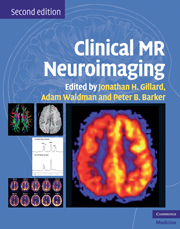Book contents
- Frontmatter
- Contents
- Contributors
- Case studies
- Preface to the second edition
- Preface to the first edition
- Abbreviations
- Introduction
- Section 1 Physiological MR techniques
- Section 2 Cerebrovascular disease
- Chapter 13 Cerebrovascular disease
- Chapter 14 Magnetic resonance spectroscopy in stroke
- Chapter 15 Diffusion and perfusion MR in stroke
- Chapter 16 Arterial spin labeling in stroke
- Chapter 17 Magnetic resonance diffusion tensor imaging in stroke
- Chapter 18 Magnetic resonance spectroscopy in severe obstructive carotid artery disease
- Chapter 19 Perfusion and diffusion imaging in chronic carotid disease
- Chapter 20 Susceptibility imaging and stroke
- Section 3 Adult neoplasia
- Section 4 Infection, inflammation and demyelination
- Section 5 Seizure disorders
- Section 6 Psychiatric and neurodegenerative diseases
- Section 7 Trauma
- Section 8 Pediatrics
- Section 9 The spine
- Index
- References
Chapter 15 - Diffusion and perfusion MR in stroke
from Section 2 - Cerebrovascular disease
Published online by Cambridge University Press: 05 March 2013
- Frontmatter
- Contents
- Contributors
- Case studies
- Preface to the second edition
- Preface to the first edition
- Abbreviations
- Introduction
- Section 1 Physiological MR techniques
- Section 2 Cerebrovascular disease
- Chapter 13 Cerebrovascular disease
- Chapter 14 Magnetic resonance spectroscopy in stroke
- Chapter 15 Diffusion and perfusion MR in stroke
- Chapter 16 Arterial spin labeling in stroke
- Chapter 17 Magnetic resonance diffusion tensor imaging in stroke
- Chapter 18 Magnetic resonance spectroscopy in severe obstructive carotid artery disease
- Chapter 19 Perfusion and diffusion imaging in chronic carotid disease
- Chapter 20 Susceptibility imaging and stroke
- Section 3 Adult neoplasia
- Section 4 Infection, inflammation and demyelination
- Section 5 Seizure disorders
- Section 6 Psychiatric and neurodegenerative diseases
- Section 7 Trauma
- Section 8 Pediatrics
- Section 9 The spine
- Index
- References
Summary
Introduction
Diffusion-weighted imaging (DWI) rapidly captured the imagination of the community working on strokes.[1,2–4] A rapid diagnostic test was needed that would not just exclude primary intracerebral hemorrhage but would also reliably identify signs of ischemia very early after stroke.[5] Introduction of perfusion-weighted imaging (PWI) increased enthusiasm further, with the idea that the diffusion–perfusion mismatch would identify the ischemic penumbra.[6] Perfusion imaging might identify regions of brain with blood flow below the level of ischemia but still above the level of permanent damage, and so enable treatments like thrombolysis to be targeted more effectively or time windows extended. Although these techniques are increasingly widely used, and have been used to select patients for clinical trials, there is still uncertainty about how best to identify tissue at risk, and practical issues have slowed their adoption into routine clinical practice. Computed tomography (CT) scanning remains the routine investigation in most acute stroke, certainly those patients considered for thrombolysis, with perfusion CT of increasing interest and availability. However, further data are also still needed to guide the use of perfusion CT. Two systematic reviews summarize data on DWI and on DWI–PWI mismatch,[7,8] and one concentrates on perfusion imaging.[9]
Technology
It is not the purpose of this chapter to detail the technology required, or the finer points of the various sequences and approaches that can be used to acquire DWI or PWI data. Chapters 4 and 7 deal with these points. Rather this chapter will highlight the most salient points for practicing stroke physicians and radiologists to be aware of when reading the literature or implementing DWI and PWI techniques in clinical practice.
Information
- Type
- Chapter
- Information
- Clinical MR NeuroimagingPhysiological and Functional Techniques, pp. 184 - 214Publisher: Cambridge University PressPrint publication year: 2009
